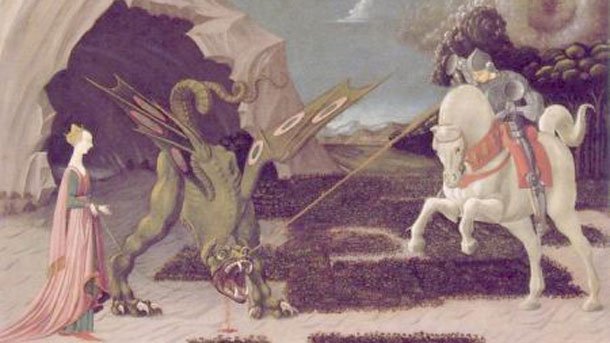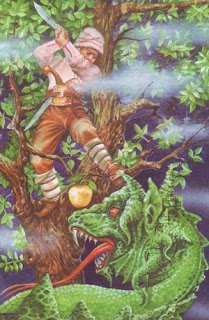The image of the dragon, a huge scaly creature with wings that breathes fire, can be found in the mythology of many nations. According to some ancient myths, the world arose from the body of a dragon defeated by a god or a hero. That is why stories telling about the fight against a monster are widespread and date back to most ancient times. With the coming of Christianity, the role of the hero was attached to the figure of St. George and acquired a religious character - the power of faith defeats the beast, which is a symbol of Satan. In Bulgarian folklore the image of the dragon appears as a creature called “Zmey”. The female Lamia or Hala is also present in Bulgarian folklore. While the male zmey could have human features and even sometimes help people, the female Lamia is always dangerous and malicious. Therefore, in Bulgarian folk legends Saint George slays a Lamia and not a dragon.
It is said that if a serpent or a fish (usually a carp) lived for forty years without being seen by human eyes, it turned into a dragon. In Bulgarian folklore, the image of the dragon could combine parts of a snake, fish, bird or human. In some cases, it is presented as a huge serpent covered with fish scales. The zmey can have 4 legs like a lizard and bird wings. It can have one eye on the forehead or a few heads. However, the zmey can also look like a person – a young, handsome, strong man with wings under the arms. The dragon has a fiery nature and can sometimes be seen as a flash of lightning or a ball of fire. Elsewhere people even call it "a cloud" and believe that it appears in the sky as a large cloud.

© Photo: archive
Dragons usually inhabit the forests and mountains. That is why people often speak of “Zmey Gorianin”, which means “forest dragon.” Zmeys are usually believed to live in caves, holes, or cracks in the rocks. Even today, dragon legends are related to the Rabishka cave and the cave near the village of Pirin in the region of Sandanski. Dragons can also live in water - lakes, wells, rivers. At various places in Bulgaria names such as Dragon’s House or Dragon’s Well still exist.
The dragon looks like a man in many ways: it eats, drinks, gets married, and has offspring. Despite having their own dragon women, zmeys can often fall in love with human girls and young brides and begin to secretly visit them at night. Such women gradually begin to stay away from others and not care much about their appearance as the zmey lover takes all their powers. Many folk songs, performed mainly on Easter, and St. George’s Day, tell the story of dragons descending from the sky and snatching their beloved girls. In other stories the zmey arrives with a whole wedding party of other zmeys riding horses. The dragon’s relationship with his human wife leads to children who look human but have wings under the arms and extraordinary power. People even speak about famous rebels as having wings under the arms and being invulnerable to enemies. In order to protect a young woman from these unwanted lovers a mixture of herbs is used and the girl bathes in it.

© Photo: archive
In folk tales, the Lamia looks like a huge lizard with a dog’s head. Her mouth is so big that it can swallow a whole man and her body is covered with yellow scales. The Lamia also has wings, four legs, sharp claws, and a long tail. Often songs tell us about three-headed, seven-headed or 9-headed Lamias. The Lamia often appears in the form of a storm or hail and destroys crops. Zmeys sometimes fight the Lamias to protect the crops.
Folk tales also tell the stories of famous heroes fighting with lamias, such as Krali Marko, who released girls and young men enslaved by the female dragon. One of the most popular Bulgarian tales, "The Three Brothers and the Golden Apple," tells the story of a brave young man who descends to the lower land and saves the king's daughter, shortly before she is eaten by the Lamia. The story is also depicted in many of the later icons of St. George due to the influence of oral traditions on Christianity.
English version: Alexander Markov
The Surva festival begins with the lighting of bonfires and mummers dancing the horo chain danie around the fires on the night of January 13-14. The power and timelessness of the masquerade tradition has led UNESCO to declare it a World Heritage..
Mummers from the neighborhoods of Bulgaria's town of Blagoevgrad, the neighboring villages and guests from Petrich paraded at a carnival in the regional town, as the sounds of hundreds of bells filled the town. For yet another year, the Mummers'..
For more than 20 years in the city of Montana, there has been a tradition on January 6 for people to go to Montanenzium Park, where there is an artificial lake, suitable for conducting the Orthodox Christian ritual called "Saving the Holy Cross" on the..

+359 2 9336 661
